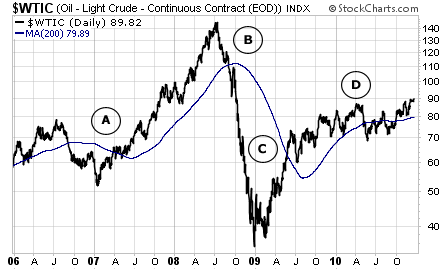Before most folks even learn the difference between a stock and a bond, they hear about "bull" and "bear" markets.
A bull market is a period of rising prices. A bear market is a period of falling prices.
But how can we make a claim that an asset is in a bull market... a bear market... or somewhere in between?
This is where the concept of the moving average is useful.
The "moving average" collects a bundle of an asset's closing prices
– say, each one from the past 200 days – then takes the average of
those prices.
This produces a chart line that "smoothes" out market volatility so
we can gauge the big-picture trend. When a market is trading above its
moving average, it's in a bull trend. When a market is trading below its
moving average, it's in a bear trend.
You can do the same thing with a 50-day moving average, a 20-day
moving average, pretty much any timeframe you want. But the most widely
used moving average on Wall Street is the 200-day moving average, a good
middle-of-the-road indicator that averages the prices from about 10
months of trading.
Let me show you how it works with an example. Below, you'll find a five-year chart of crude oil...
In early 2007, the price of crude oil moved out of a sideways
trading pattern and crossed above its 200-day moving average (A). It
continued this price strength and climbed toward a huge top at $145 per
barrel.
In mid-2008, oil had come down off its top and crossed below its
200-day moving average (B) on the way to a crushing $35 per barrel
bottom.
Months later, oil moved higher yet again, crossing above its
200-day moving average in early 2009 (C) and signaling a new bull
market.
Except for some "whipsaws" (D) this summer, where the trend was
unclear, the 200-day moving average served as "guidepost" for gauging
the big-picture trend in oil.
If you wanted to take the easy way out, all you had to do was buy
oil when it crossed above its 200-day moving average and sell it when it
fell back below. Though oil is only up 40% since early 2007, you would
have made nearly 150%.
For the majority of traders, however, moving averages won't solely
dictate buy and sell decisions. But they can serve as handy guideposts
when you're studying trends.
Good trading,
Brian Hunt
P.S. If you'd like to print out our full guide on "common sense" technical analysis,
. You'll also find it posted on the
.
We hope you use the techniques we showed you this week to trade
profitably in 2011 and beyond. And as always, thanks for reading

































